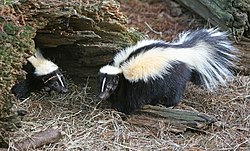
Skunk oil, also referred to as skunk grease, is an oil that is obtained from the two lateral glands that run the length of a skunk's back. Skunks store fat in these glands for use during hibernation or semi-hibernation in warmer climates. Skunk oil has minimal odor. [1]